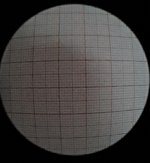Other brief observations on the 10x NL.
- Very low CA. Very similar to my ATX 95 in that CA is barely perceptible anywhere close to the center. Towards the far edges, there are the typical lateral CA yellow-green and violet-magenta lines at outer/inner edges of high-contrast lines, but these are very narrow and, like Pekka said about the 8x, only visible if one looks for them, which is inconvenient with the FoV being as wide as it is.
- Extremely sharp image which snaps to focus easily and is relaxing to view. I used a Zeiss tripler (3x12 monocular) to assess image sharpness with the binoculars tripod-mounted, viewing a USAF 1951 2" vapour-deposited glass target. Due to time constraints, I did not attempt to define a precise resolution limit, but will say that what I saw at 30x was the cleanest image I have yet seen in a binocular, very close to what I expect in a high-quality telescope when magnified or boosted to similar exit pupils.
- A quick and dirty artificial star test (at 30x) showed no prism line and perfectly circular diffraction patterns both inside and outside focus. Inside focus (infinity side of focus for my 10 distant target) showed very clear and evenly illuminated rings all the way to focus stop, while outside focus (closer than target) showed fuzzier circles with some concentration of light toward the central spot, meaning some SA but, again, significantly less than typical for even high-quality binoculars. The left tube was probably the best binocular tube I have seen, while the right tube was not quite as excellent (probably a little more SA, just a tad less sharp looking target at 30x) but still among the best I have seen in binoculars.
Inside focus diffraction rings had purple on the outside of the outermost ring while outside focus rings had green, but this also was less than typically seen - not unlike what I see in Swarovski's HD spotting scopes.
Viewing towards the sun with the sun some 10 degrees above the horizon, there was some veiling glare towards the bottom of the image. This mostly stayed at the edge or, at most, bottom third of the image, but was immediately noticeable to me when comparing with the Canon which is one the best I have used in this regard. At around sunset, I viewed some more, and here again the NL had more veiling glare than the Canon. As it stayed away from the image center, it did not bother me too much, but this was the one area where the NL was less than state-of-the-art in my view.
I'll conclude with a couple of observations about the forehead rest. I'm one of those viewers who tends to view with eyecups resting on my forehead and nose bridge, i.e. interfacing with my skull. If this is not possible, I press my thumbs against my cheekbones and rest the binoculars between my palms. Compared to these ways of holding the binoculars, I detected no difference from using the forehead rest. However, when I tried viewing with my glasses on (which I don't usually do), the forehead rest was extremely good. It allowed me to keep the eyecups down far enough so that they barely touched my glasses, allowing the glasses to stay perfectly positioned and aligned to my pupils the way the optician had intended, while the binocular stayed aligned to my eyes as it was "anchored" in place by the forehead rest. I can easily see that for eyeglass wearers this could quickly become a must.
Kimmo





